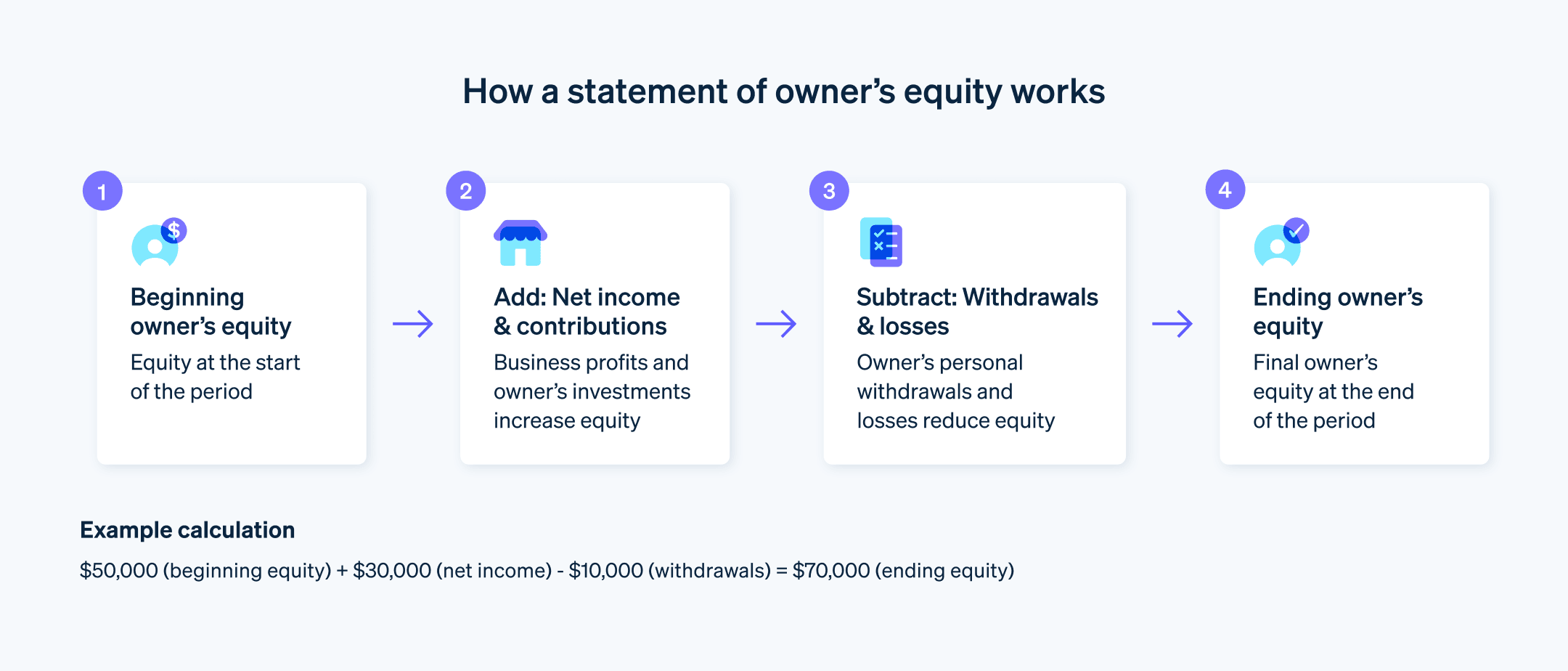股东权益变动表,也称为股东权益变化表 (Statement of Changes in Equity),是一个财务文件,展示了企业在一定时期内股东权益的变化。该报表从股东的角度提供了企业财务表现的总结,是企业财务报表中的重要组成部分,通常与资产负债表和利润表一起使用。通常,它是继利润表之后创建的第二个财务报表。
以下是企业主需要了解的关于股东权益变动表的概述:包含什么内容、如何使用以及如何编写。
目录
- 股东权益变动表如何使用?
- 股东权益变动表与现金流量表有何关系?
- 股东权益变动表的关键元素
- 如何准备和格式化股东权益变动表
- 股东权益变动表的示例
- 股东权益变动表的优点和局限性
股东权益变动表如何使用?
股东权益变动表提供了一个关于所有直接影响股东在企业中净投资的企业活动的财务概览。该文件有几个重要的用途,无论是内部还是外部使用:
绩效评估: 这份报表让企业主和利益相关者评估企业在特定期间内的表现。通过检查股东权益的变化,利益相关者可以衡量企业为股东创造价值的能力。
投资决策: 潜在的和现有的投资者使用此报表来了解企业的财务健康状况,并做出有关购买、出售或持有其投资的明智决策。
信用分析: 借款人和债权人查看这份报表,以评估企业的财务稳定性及偿还贷款的能力。增长的股东权益可能表明债权人面临的风险较低。
财务分析: 这份报表帮助财务分析师了解诸如盈利留存或分配政策等业务活动如何影响股东权益。
内部规划: 管理层使用这份报表做出关于业务再投资、分配给股东或其他财务战略的关键决策,以改善企业的增长和稳定性。
税务目的: 这份报表在税务规划和报告中可能是相关的,特别是对于税收基于股东个人收入的企业。
股东权益变动表与现金流量表有何关系?
股东权益变动表和现金流量表是两个独立的财务报表,它们提供了企业财务健康的不同视角。股东权益变动表关注企业在特定时期内股东权益的变化,展示了净收入、股东投资和提取如何影响股东权益。现金流量表则详细列出了企业的现金流入和流出,并将它们分为经营、投资和融资活动。
这两份报表共同提供了一个企业财务的全面视图。尽管股东权益变动表展示了企业的表现和股东交易如何影响总权益,并反映了企业净值的变化,现金流量表则提供了这些及其他活动如何影响企业现金状况的见解。这决定了企业的流动性和财务稳定性,并揭示了企业在满足义务和资助运营方面的现金生成能力。这两份报表为决策者和分析师提供了重要的见解。
尽管这两份报表侧重点不同,但它们包含的部分数据是相互关联的。净收入会影响股东权益,并作为现金流量表经营活动部分的起点。股东提款(取款)也会影响股东权益,通常在现金流量表的融资活动部分体现。股东权益变动表提供了股东权益变化的概览,但现金流量表则展示了这些变化如何反映在现金流动中。
股东权益变动表的关键元素
股东权益变动表的元素展示了在一个会计期间内,企业活动如何影响股东权益。利益相关者可以使用这些信息来评估财务表现和股东投资的变化。
期初股东权益: 这是会计期初的股东权益金额。它代表了在所有负债从资产中扣除后的企业主的权益。
投入资本: 这些是企业主在会计期间所做的额外投资。
净收入: 这是企业在扣除所有费用(包括税费和利息)后的收入。它是企业在该期间内产生的利润。利润表中的净收入会被加入到股东权益中。
股东提款(取款): 这是企业主在会计期间从企业中提取的用于个人用途的资金或价值。取款会减少股东权益,因为它代表了从企业中提取的资产。
其他调整: 这些是影响股东权益但不适合归入其他类别的调整。它们可能包括会计政策的变化或错误的更正。
期末股东权益: 这是会计期末企业主在企业中的权益。它通过以下方式计算:从期初权益中加上投入资本和净收入,再减去任何取款和调整。

如何准备和格式化股东权益变动表
第 1 步:标题和抬头
标题: 该文件应标题为“股东权益变动表”,以清晰标明其用途。
抬头: 包括企业名称和报表所涵盖的期间(例如:“截至 2024 年 12 月 31 日的年度”)。
第 2 步:期初股东权益
- 期初股东权益: 该数字为上一会计期间的期末股东权益。
第 3 步:股东权益的增加
投入资本: 列出企业主在会计期间内做出的任何投资或额外资本。
净收入: 列出来自利润表的净收入。该收入会增加股东权益。如果企业出现亏损,则会减少股东权益。
第 4 步:股东权益的扣减
- 股东取款: 列出企业主的任何取款或分配。这会减少股东权益。
第 5 步:期末股东权益
- 期末股东权益: 通过将投入资本和净收入加到期初股东权益,再减去任何取款或亏损来计算期末股东权益。以下是计算方法的示例:
50,000 美元(期初权益)+ 30,000 美元(净收入)- 10,000 美元(取款)= 70,000 美元(期末权益)
格式要求
行项: 将上述每个元素作为单独的行项表示。
保持一致: 将所有数字对齐到页面的右侧。
小计: 在每个部分之后提供小计。
最终结果: 清晰标注并区分最终数字,即期末股东权益。
股东权益变动表的示例
以下是两个假设的小型企业 ABC 咨询公司和 XYZ 设计工作室的股东权益变动表示例。这些示例展示了根据全年不同的财务活动,股东权益变动表的结构。
示例 1:ABC 咨询公司
ABC 咨询公司
股东权益变动表
截至 2024 年 12 月 31 日的年度
2024 年 1 月 1 日的期初股东权益: 50,000 美元
加: 2024 年净收入:30,000 美元
减: 股东取款:10,000 美元
2024 年 12 月 31 日的期末股东权益: 70,000 美元
示例 2:XYZ 设计工作室
XYZ 设计工作室
股东权益变动表
截至 2024 年 12 月 31 日的年度
- 2024 年 1 月 1 日的期初股东权益: 80,000 美元
- 加: 2024 年期间投入资本:20,000 美元
- 加: 2024 年净收入:40,000 美元
- 减: 所有者提款:25,000 美元
- 2024 年 12 月 31 日的期末股东权益: 115,000 美元
股东权益变动表的优点和局限性
优点
股东洞察: 该报表为企业主提供了清晰的视角,展示了他们在企业中的财务权益,显示了企业运营和决策如何影响他们的权益。这些信息可能会影响企业主是否将利润再投资或提取收益的决策。
性能跟踪: 该报表可以追踪企业财务表现的变化,展示保留盈余和额外投资如何促使股东权益的增长。
投资者决策: 潜在投资者可以利用该报表来判断企业的财务健康状况和稳定性,从而做出投资决策。
财务透明度: 该报表通过展示利润是如何在企业中保留或分配给股东的,提供了财务报告的透明度。这一点对于内部和外部的利益相关者都至关重要。
局限性
范围: 尽管该报表提供了股东权益变动的重要信息,但它并未提供企业财务健康状况的完整视图,必须与其他财务报表一起解读。
及时: 像所有财务报表一样,股东权益变动表呈现的是历史数据。尽管这些信息有价值,但它可能并不总是反映企业的当前或未来财务状况。
行政负担: 准备该报表可能是耗时的,尤其是对于那些拥有多种股东权益账户或权益频繁变动的企业。
Stripe Atlas 如何提供助力
Stripe Atlas 可为贵公司搭建法律框架,助贵公司在全球任意地点仅需两个工作日即可完成融资、开设银行账户及接受付款。
已有超 7.5 万家企业通过 Stripe Atlas 完成注册,其中包括获 Y Combinator、a16z 及 General Catalyst 等顶级投资机构支持的初创公司。
申请加入 Atlas
使用 Stripe Atlas 申请注册公司仅需不到 10 分钟。贵方可自主选择公司架构,即时核验公司名称是否可用,并添加最多四位联合创始人。贵方还需确定股权分配方案,为未来投资者和员工预留股权池,任命公司高管,最后通过电子签名签署所有文件。所有联合创始人也将收到邮件邀请,通过电子签名签署其对应文件。
在获取雇主识别号 (EIN) 前开通收款与银行账户功能
公司注册完成后,Stripe Atlas 将为贵方申请雇主识别号 (EIN)。持有美国社保号、美国地址及手机号码的创始人可享受美国国税局 (IRS) 加急处理服务,其他情况将适用标准处理流程(耗时可能稍长)。此外,Stripe Atlas 支持在 EIN 获批前开通收款与银行账户功能,助您在等待税务编号期间即可开展交易。
无现金式创始人股票认购
创始人可使用知识产权(如版权或专利)替代现金认购初始股份,相关认购凭证将存储于贵方 Atlas 管理后台。使用该功能需满足知识产权估值不超过 100 美元的条件;若您持有的知识产权价值高于此限额,请在操作前咨询专业律师。
自动提交 83(b) 税务申报
创始人可通过提交 83(b) 税务申报降低个人所得税负。无论贵方是美国籍或非美国籍创始人,Stripe Atlas 均可代为完成申报流程——采用 USPS 认证邮件寄送并附带物流追踪服务。贵方可直接在 Stripe 管理后台获取已签收的 83(b) 申报表及官方寄送凭证。
全球顶尖水准的公司法律文件
Atlas 为贵方提供创办公司所需的全部法律文件。Atlas 的 C 类股份有限公司文件由全球顶尖风投律所美国科律律师事务所 Cooley 联合设计,旨在助贵方立即启动融资,并确保公司获得全方位法律保护,涵盖股权架构、权益分配及税务合规等核心领域。
Stripe 支付服务首年免费,更享价值 5 万美元的合作伙伴专属优惠与折扣
Atlas 与顶级合作伙伴深度联动,为创始人提供独家优惠与资源支持,涵盖 AWS、Carta、Perplexity 等行业领军企业的工程开发、税务合规、财务管理及运营必备工具折扣,更免费赠送首年特拉华州法定注册代理服务。作为 Atlas 用户,贵方还将解锁 Stripe 专属权益——最高 10 万美元交易额的全年免费支付处理服务。
了解更多关于 Atlas 如何助您极速开启创业之旅,即刻启航。
本文中的内容仅供一般信息和教育目的,不应被解释为法律或税务建议。Stripe 不保证或担保文章中信息的准确性、完整性、充分性或时效性。您应该寻求在您的司法管辖区获得执业许可的合格律师或会计师的建议,以就您的特定情况提供建议。